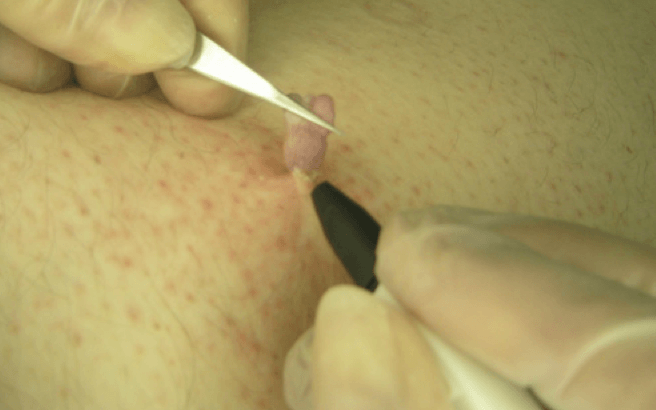At Cheshire Lasers, Facial Surgeon Mr Will Allen, Aesthetic Nurse Moira, Dr Kathryn Hazlehurst and Advanced Electrolysis technician Helena perform Skin Tag Removal.
What are Skin Tags?
Skin tags are small flesh-coloured or brown growths that hang off the skin. They are very common and harmless.
Skin tags are usually a few millimetres in size, although they can be as big as 5cm.
They are often found on the neck, armpits, around the groin or under the breasts. They can also grow on the eyelids and under the folds of the buttocks.
The medical name for skin tags is acrochordons.
Why do Skin Tags occur?
Anyone can develop skin tags, but they are particularly common in older people, and some develop them for no apparent reason.
Skin tags often grow where skin rubs against skin or clothing. This would explain why they tend to affect overweight people who have excess folds of skin and skin chafing.
When skin tags can be a problem
Skin tags are harmless and do not usually cause pain or discomfort.
However, you may want to consider their removal if they are unsightly. They can affect some peoples self-esteem or can snag on clothing or jewellery and bleed.
Skin tag removal is a cosmetic procedure, which is very rarely available through the NHS. Generally, the NHS will only carry out cosmetic surgery procedures if the problem is affecting your physical or mental health.
Sometimes, skin tags fall off on their own if the tissue has twisted and died from a lack of blood supply.
Removing skin tags
Skin tags can be removed using electrocautery, cryotherapy (frozen off ) or surgically.
If your skin tag is small with a narrow base, your GP may suggest you try removing it yourself by:
- tying off the base of the skin tag with dental floss or cotton to cut off its blood supply and make it drop off
- cutting it off with fine sterile scissors
Do not attempt to remove large skin tags yourself because they will bleed heavily.
Skin Tag Removal at Cheshire Lasers
At Cheshire Lasers Clinic, the following specialists perform skin tag removal:
Facial Surgeon Mr Will Allen uses a range of treatments, including cryotherapy and electrocautery.
Aesthetic Nurse Moira and Dr Kathryn Hazlehurst use:
- Cryotherapy – a treatment that freezes and destroys the lesion which then dies and drops off several days later.
- Advanced Electrocautery – the lesion is excised using a fine electrical cutting tip
Advanced Electrolysis technician Helena removes skin tags using advanced electrolysis very similar to electrocautery – the lesion is excised using a fine electrical cutting tip.
If you have multiple skin tags, it is quicker and more cost-effective to have a liquid nitrogen treatment.
For very small skin tags that are very small or close to to the eye, we recommend the intricate work of electrocautery or advanced electrolysis is better.
For large skin tags we recommend you book in with Surgeon Mr Will Allen or Aesthetic Nurse Moira in case you require minor surgery.
What is the cost of removing skin tags?
View Prices for Facial Surgeon Mr Will Allen here.
Check out Aesthetic Nurse Moira’s prices for skin tag removal here.
View prices for Dr Kathryn Hazlehurst here.
Check out Helena’s Advanced Electrolysis Prices here.
As this is a cosmetic procedure, you do not need a referral letter from your GP.
Our Medical team can often perform your treatment on the day of your consultation, but if you have many skin tags or if they are in an unusual position, we recommend you phone us to discuss before you book a consultation/treatment appointment.
Helena has to perform a consultation and a patch test on one of the skin tags before treating further skin tags at a separate appointment.
Here is a photo before and immediately after a skin tag treatment near the eye area
This image demonstrates the appearance of the skin before and immediately after an electrocautery skin tag removal treatment close to the eye area. Two skin tags have been removed in the centre of these images a larger skin tag and a smaller one.
As you can see with electrocautery the response can be seen immediately, however, the surrounding skin may look red and inflamed for a few hours to a few days later.
You will see a scab form at the treatment site and some dry, shrivelled skin where the lesion was located the area will soon recover and it is usually fully healed within seven days.
Complications are rare after this treatment; however, infection, reaction to anaesthesia, lesion recurrence, skin atrophy, skin ulceration, skin discolouration and the formation of a scar can occur.
View some of Helena Fryer’s patients before and after skin tag treatment here:
View some of Aesthetic Nurse Moira’s patients before and after skin tag treatment here:










